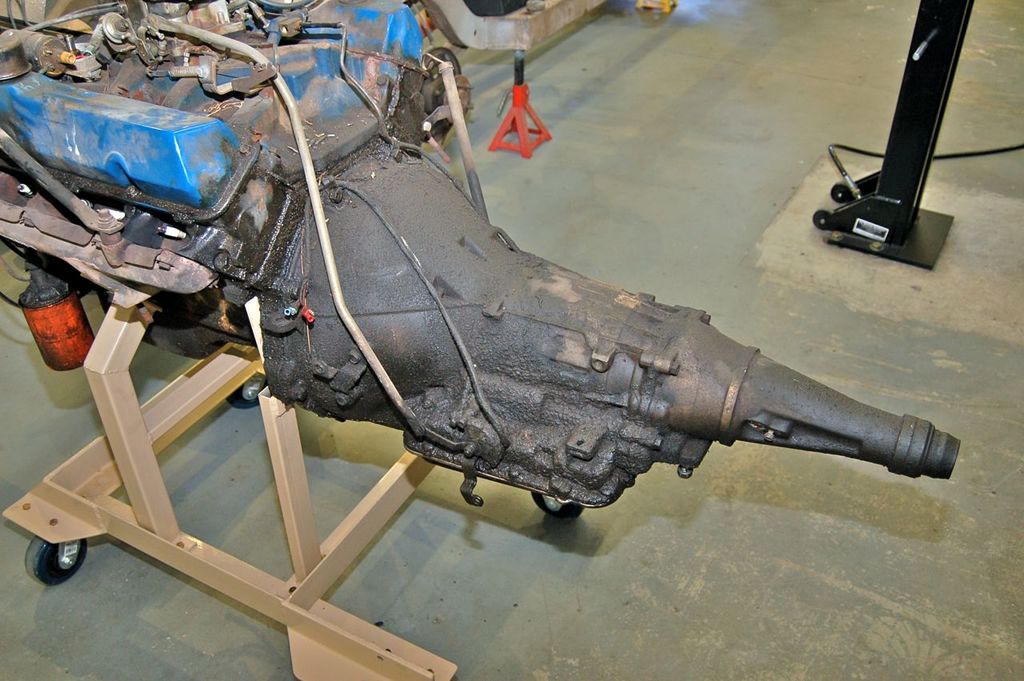Hi all,
Thought I'd share pics and information on a build up of a 1966 C6 transmission I've recently completed. The intent of this is to show it's really not that bad to rebuild and/or modify a transmission. Hopefully from the plethora of pictures you can get a pretty good idea of whats involved. As always there are seven ways to Sunday to do something. This is just how I did it and is no way meant to be the best.
In this I chose to break this up into 3 major parts/threads and then later a follow up. The first part is just tear down, the second will be the modifications of which if you just wish to do a factory rebuild just skip this section. The third part will be assembly. Later I'll do a follow up once the engine is back from the machine shop and the car reassembled and the transmission shift points and line pressures (quality of shift) are fine tuned.
OK enough of all that here's my starting point:
![Image]()
The trans is behind a low horsepower 390 (2bl, single exhaust, "small cam", lower compression, etc) with the technical designation PDD-B model (column shift) 1966 dual range.
![Image]()
First thing I wanted to do was build a proper stand for ease of workability. While you can rebuild one on a bench or I've even seen folks use an old wooden chair with a hole through the seat and the transmission mounted to it, I wanted something just a tinge more elegant and easier to access all sides.
![Image]()
With some scrap pieces of steel from previous projects I was able to contrive this and use my engine stand. It's a bit "Erector Set" looking but worked really well. I even guessed really close on the CG, sans convertor, as it's really easy to spin round.
![Image]()
I've cleaned the transmission at this point and familiarized myself with it and we'll start here with tear down. First off remove the input shaft if it hasn't already fallen out on you. It just pulls out.
![Image]()
Remove the pan.
![Image]()
Remove the valve body, just remove the unfastened bolts shown and it lifts out as one piece.
![Image]()
Actually doesn't look that complex even at this point.
![Image]()
To remove the band forks loosen the jamb nut and the adjuster on the side of the case, the apply forks will then fall free to remove.
![Image]()
The pile of parts slowly grows.
![Image]()
Next remove the bolts holding the pump to the case.
![Image]()
Use a screw driver to push the guts and subsequently the pump forward and remove the pump.
![Image]()
Maneuver the band out through the front.
![Image]()
Pull the High-Reverse clutch (aka direct clutch) forward and out. Use two hands as it's heavy.
![Image]()
Grab the Forward Clutch and pull that out. Again two hands..
![Image]()
Next grab the sun shell and pull that straight out. Note the forward planetary is still in it and will fall out if tipped so be careful or pull that out first and then the shell.
![Image]()
The parts removed in order.
![Image]()
Remove the snap ring holding the reverse planetary onto Low-Reverse clutch hub.
![Image]()
Remove the reverse planetary.
![Image]()
It's hard to see but on the shaft stub against the back hub there is a snap ring holding the reverse ring gear and hub in.
![Image]()
Use snap ring pliers and remove it.
![Image]()
like so
![Image]()
While rotating pull forward on the Low-Reverse clutch hub.
![Image]()
Remove the snap ring holding in the pressure plate, frictions and steels of the Low-Reverse clutch.
![Image]()
And remove them all.
![Image]()
Remove the tail shaft housing.
![Image]()
Grasp the tail tail shaft and pull straight out supporting it as it comes out so you do not damage the governor sleeve.
![Image]()
Remove the governor sleeve
![Image]()
You might have to wiggle and jiggle the sleeve feed and modulated governor tubes free.
![Image]()
Remove the parking gear and its thrust washer.
![Image]()
Remove the kick-down lever nut, lever and shaft.
![Image]()
Remove the neutral-park starter and backup light switch.
![Image]()
Unbolt the manual shift linkage assembly nut and remove the parts.
![Image]()
The parking pawl rod actuator.
![Image]()
And pull the manual shaft out.
![Image]()
Unscrew the vacuum modulator.
![Image]()
Remove the pin the modulator valve from the case.
![Image]()
There's a steel ball bearing holding this band apply pin in place, use a punch to carefully drive the ball forward out the front of the case pump area.
![Image]()
like so
![Image]()
Remove the fulcrum pin and apply lever.
![Image]()
Remove the oil cooler lines from the case as there are O-rings that need to be replaced behind them.
![Image]()
This year C6 has a vent tube, remove it.
![Image]()
Remove the servo from the case.
![Image]()
Remove the parking rod guide plate
![Image]()
As well as the parking pawl and spring.
![Image]()
Very carefully use a punch to drive this pivot shaft down and this will push out the welch plug holding it in.
![Image]()
You can reuse the plug if it comes out without damage.
![Image]()
Use a 1/4" x 20 bolt and screw into the bottom of the pin and pull it out.
Please see the next post to this as I've hit my limit on images.
Thought I'd share pics and information on a build up of a 1966 C6 transmission I've recently completed. The intent of this is to show it's really not that bad to rebuild and/or modify a transmission. Hopefully from the plethora of pictures you can get a pretty good idea of whats involved. As always there are seven ways to Sunday to do something. This is just how I did it and is no way meant to be the best.
In this I chose to break this up into 3 major parts/threads and then later a follow up. The first part is just tear down, the second will be the modifications of which if you just wish to do a factory rebuild just skip this section. The third part will be assembly. Later I'll do a follow up once the engine is back from the machine shop and the car reassembled and the transmission shift points and line pressures (quality of shift) are fine tuned.
OK enough of all that here's my starting point:

The trans is behind a low horsepower 390 (2bl, single exhaust, "small cam", lower compression, etc) with the technical designation PDD-B model (column shift) 1966 dual range.

First thing I wanted to do was build a proper stand for ease of workability. While you can rebuild one on a bench or I've even seen folks use an old wooden chair with a hole through the seat and the transmission mounted to it, I wanted something just a tinge more elegant and easier to access all sides.

With some scrap pieces of steel from previous projects I was able to contrive this and use my engine stand. It's a bit "Erector Set" looking but worked really well. I even guessed really close on the CG, sans convertor, as it's really easy to spin round.

I've cleaned the transmission at this point and familiarized myself with it and we'll start here with tear down. First off remove the input shaft if it hasn't already fallen out on you. It just pulls out.

Remove the pan.

Remove the valve body, just remove the unfastened bolts shown and it lifts out as one piece.

Actually doesn't look that complex even at this point.

To remove the band forks loosen the jamb nut and the adjuster on the side of the case, the apply forks will then fall free to remove.

The pile of parts slowly grows.

Next remove the bolts holding the pump to the case.

Use a screw driver to push the guts and subsequently the pump forward and remove the pump.

Maneuver the band out through the front.

Pull the High-Reverse clutch (aka direct clutch) forward and out. Use two hands as it's heavy.

Grab the Forward Clutch and pull that out. Again two hands..

Next grab the sun shell and pull that straight out. Note the forward planetary is still in it and will fall out if tipped so be careful or pull that out first and then the shell.

The parts removed in order.

Remove the snap ring holding the reverse planetary onto Low-Reverse clutch hub.

Remove the reverse planetary.

It's hard to see but on the shaft stub against the back hub there is a snap ring holding the reverse ring gear and hub in.

Use snap ring pliers and remove it.

like so

While rotating pull forward on the Low-Reverse clutch hub.

Remove the snap ring holding in the pressure plate, frictions and steels of the Low-Reverse clutch.

And remove them all.

Remove the tail shaft housing.

Grasp the tail tail shaft and pull straight out supporting it as it comes out so you do not damage the governor sleeve.

Remove the governor sleeve

You might have to wiggle and jiggle the sleeve feed and modulated governor tubes free.

Remove the parking gear and its thrust washer.

Remove the kick-down lever nut, lever and shaft.

Remove the neutral-park starter and backup light switch.

Unbolt the manual shift linkage assembly nut and remove the parts.

The parking pawl rod actuator.

And pull the manual shaft out.

Unscrew the vacuum modulator.

Remove the pin the modulator valve from the case.

There's a steel ball bearing holding this band apply pin in place, use a punch to carefully drive the ball forward out the front of the case pump area.

like so

Remove the fulcrum pin and apply lever.

Remove the oil cooler lines from the case as there are O-rings that need to be replaced behind them.

This year C6 has a vent tube, remove it.

Remove the servo from the case.

Remove the parking rod guide plate

As well as the parking pawl and spring.

Very carefully use a punch to drive this pivot shaft down and this will push out the welch plug holding it in.

You can reuse the plug if it comes out without damage.

Use a 1/4" x 20 bolt and screw into the bottom of the pin and pull it out.
Please see the next post to this as I've hit my limit on images.















